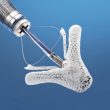According to this new study, in patients with coronary disease, diabetes, and chronic kidney disease who underwent revascularization through angioplasty or surgery, events are similar. This is one of the first studies painting the real picture for the prognosis of patients revascularized in these conditions (diabetes plus chronic kidney disease). At first sight, these...
Good Outcomes for MitraClip “Off Label”
Courtesy of Dr. Carlos Fava. Mitral regurgitation is the most frequent type of valve disease, accounting for >6% of patients over 65 years old. Surgery is currently the strategy of choice, but percutaneous treatment is a valid alternative. The long-term progress of symptomatic patients at high surgical risk who do not meet the formal indications for...
The Ten Commandments for the Fourth Universal Definition of Infarction
The Fourth Universal Definition of Myocardial Infarction is a document developed jointly by the European Society of Cardiology (ESC), the American College of Cardiology (ACC), the American Heart Association (AHA), and the World Heart Federation (WHF). The Fourth Definition was necessary for multiple reasons, including increasingly higher troponin sensitivity. While troponin obviously does not...
Outcomes of Contemporary DES in Patients with Diabetes: Do They Render Freedom Obsolete?
Despite our high hopes for new-generation drug-eluting stents (DES), patients with diabetes still have a different prognosis, both clinical and angiographic, compared with non-diabetic patients. Authors sought to investigate the impact of diabetes on patients who underwent drug-eluting stent implantation in the BIONICS (BioNIR Ridaforolimus Eluting Coronary Stent System in Coronary Stenosis) trial. This...
Percutaneous Closure Systems Are Safe in TAVR and Aneurysms
Courtesy of Dr. Carlos Fava. Currently, one of our medical challenges is to conduct procedures requiring access with large introducer sheaths in a simpler way, without requiring surgical intervention and closing with percutaneous devices while maintaining procedural quality and safety. There are several devices, but they require a learning curve and the only information available comes...
These Were the Most Relevant Article of 2018 in the Field of Coronary Diseases
1- The CULPRIT-SHOCK Study Is Finally Published in NEJM and It Is Bound to Change Guidelines During SOLACI’s coverage of the TCT 2017 Congress in Denver, Colorado, we already mentioned some of the outcomes of this study that has arrived to revolutionize clinical practice, given the differences between its results and those of the classic...
More Evidence For MitraClip in High Risk Patients with Severe Tricuspid Regurgitation
Courtesy of Dr. Carlos Fava. Tricuspid regurgitation (TR) has a negative impact in the long run. Several reports have shown that, in high risk inoperable patients, transcatheter edge-to-edge valve repair with MitraClip is feasible, safe and has good results, but there is still a long way to go. The present study looked at 24 consecutive...
Treating Tricuspid and Mitral Valves with MitraClip Improves Quality of Life
Courtesy of Dr. Carlos Fava. It has been shown that significant tricuspid regurgitation (TR) is an independent predictor of bad evolution in the presence of mitral valve disease. Its prevalence is not low, reaching up to 50% in patients undergoing surgery for mitral regurgitation (MR). This study included 61 patients with significant TR and MR. 27...
Urgent/Emergent TAVR: A Valid Option
Courtesy of Dr. Carlos Fava. Aortic stenosis with cardiac failure or cardiogenic shock involves high mortality risk at short term. Surgery in these conditions is often unsafe, which leaves us with valvuloplasty, but only as a bridge to some other procedure, seeing as it is effective only for a short time. Few studies have looked into patients undergoing...
CTO Revascularization Improves Quality of Life
Courtesy of Dr. Carlos Fava. The presence of CTO hovers around 15, 20% in coronary angiographies of patients with chronic stable angina, but only 5% receive percutaneous coronary intervention (PCI). One of the obstacles to percutaneous revascularization is the lack of relevant studies justifying it, though we do have different comparative studies that improve symptoms, ventricular...









